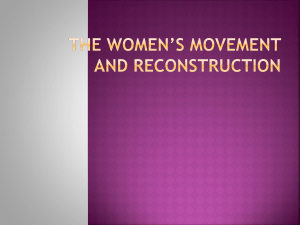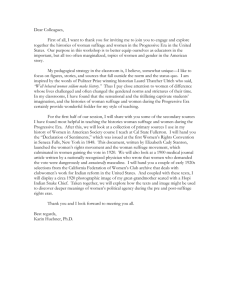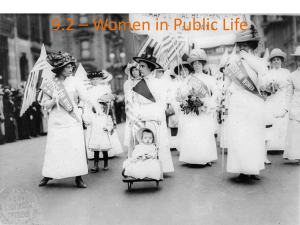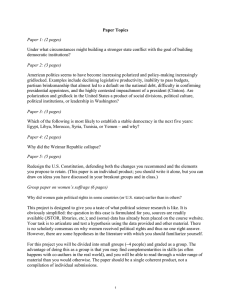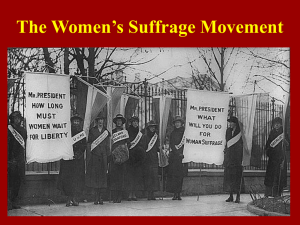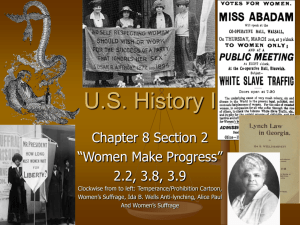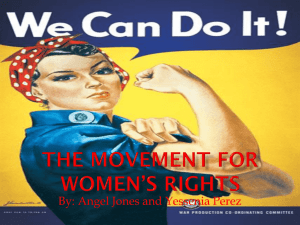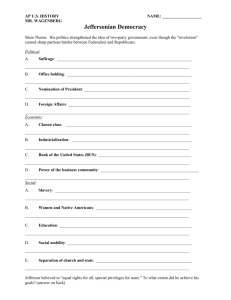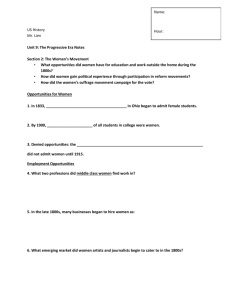CPE 7: Notes on Divided Sovereignty, Constitutional Exchange, and Democracy
advertisement
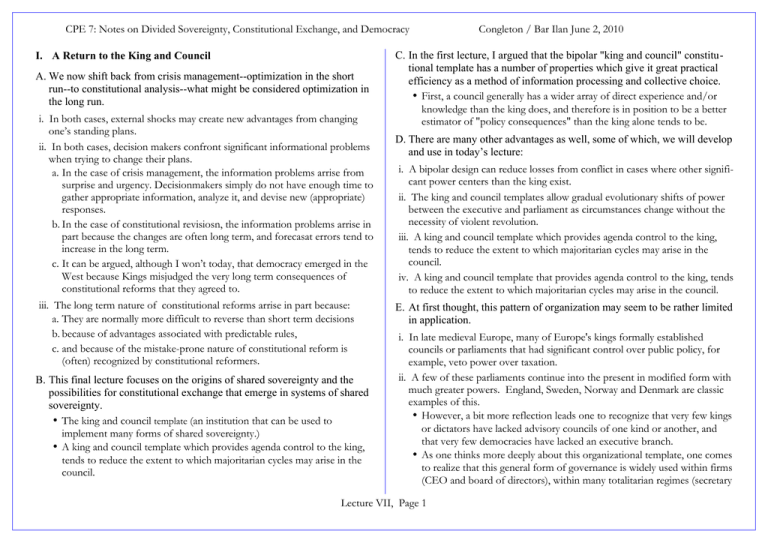
CPE 7: Notes on Divided Sovereignty, Constitutional Exchange, and Democracy I. A Return to the King and Council A. We now shift back from crisis management--optimization in the short run--to constitutional analysis--what might be considered optimization in the long run. i. In both cases, external shocks may create new advantages from changing one’s standing plans. ii. In both cases, decision makers confront significant informational problems when trying to change their plans. a. In the case of crisis management, the information problems arrise from surprise and urgency. Decisionmakers simply do not have enough time to gather appropriate information, analyze it, and devise new (appropriate) responses. b. In the case of constitutional revisiosn, the information problems arrise in part because the changes are often long term, and forecasat errors tend to increase in the long term. c. It can be argued, although I won’t today, that democracy emerged in the West because Kings misjudged the very long term consequences of constitutional reforms that they agreed to. iii. The long term nature of constitutional reforms arrise in part because: a. They are normally more difficult to reverse than short term decisions b. because of advantages associated with predictable rules, c. and because of the mistake-prone nature of constitutional reform is (often) recognized by constitutional reformers. B. This final lecture focuses on the origins of shared sovereignty and the possibilities for constitutional exchange that emerge in systems of shared sovereignty. w The king and council template (an institution that can be used to implement many forms of shared sovereignty.) w A king and council template which provides agenda control to the king, tends to reduce the extent to which majoritarian cycles may arise in the council. Congleton / Bar Ilan June 2, 2010 C. In the first lecture, I argued that the bipolar "king and council" constitutional template has a number of properties which give it great practical efficiency as a method of information processing and collective choice. w First, a council generally has a wider array of direct experience and/or knowledge than the king does, and therefore is in position to be a better estimator of "policy consequences" than the king alone tends to be. D. There are many other advantages as well, some of which, we will develop and use in today’s lecture: i. A bipolar design can reduce losses from conflict in cases where other significant power centers than the king exist. ii. The king and council templates allow gradual evolutionary shifts of power between the executive and parliament as circumstances change without the necessity of violent revolution. iii. A king and council template which provides agenda control to the king, tends to reduce the extent to which majoritarian cycles may arise in the council. iv. A king and council template that provides agenda control to the king, tends to reduce the extent to which majoritarian cycles may arise in the council. E. At first thought, this pattern of organization may seem to be rather limited in application. i. In late medieval Europe, many of Europe's kings formally established councils or parliaments that had significant control over public policy, for example, veto power over taxation. ii. A few of these parliaments continue into the present in modified form with much greater powers. England, Sweden, Norway and Denmark are classic examples of this. w However, a bit more reflection leads one to recognize that very few kings or dictators have lacked advisory councils of one kind or another, and that very few democracies have lacked an executive branch. w As one thinks more deeply about this organizational template, one comes to realize that this general form of governance is widely used within firms (CEO and board of directors), within many totalitarian regimes (secretary Lecture VII, Page 1 CPE 7: Notes on Divided Sovereignty, Constitutional Exchange, and Democracy general and polit bureau), within military organizations (commander and war council), and within the church (pope and congress of cardinals). iii. The "king and council" template is scalable, and is widely used to make decisions within many hierarchical organizations. For example, such "committee and executive" decision making procedures are common place within universities and other nonprofit organizations. II. Sharing Sovereignty: Beyond Informational Advantage of the King and Council Model A. This lecture analyzes conditions under which the King and Council have direct power over public policy. i. Why is formal policy making authority often granted to councils or executives initially created for the convenience of a dominant executive or parliament? B. The most plausible answer to this question is that in many circumstances policy making power can be used as a tradable good in a voluntary exchange between king and council or between the government and parties outside government. i. For example, modest grants of power may be explained in the context of a supremely powerful king or president as a form of compensation for council members with a direct financial or ideological interest in public policy. ii. Three other possibilities are explored below. C. Sharing Policymaking Authority To Obtain Organizational Resources i. Organizational effectiveness can occasionally be increased by sharing policymaking authority. ii. For example, consider members of a pear cooperative or cherry-picking firm. a. Prospective team members with ladders or who are especially adept at climbing trees may be more willing to participate in the annual harvests of these organization, if they have some veto authority over the use of the ladders or the trees to which they are assigned. Congleton / Bar Ilan June 2, 2010 b. Exit is, of course, always possible if they are misused, but risk of damages (broken ladders and legs) can be reduced by giving such valuable team members the right to participate in decisions regarding the use of their ladders and assignments to particular tree tops. iii. Similarly, a regional government that confronts an external threats from pirates or Vikings may benefit from the use of commercial ships in defense of their communities. a. The owners of such ships, however, may be unwilling to allow their ships to be entirely subject to the command of the regional government. b. They might fear, for example, that the government would assign their ships to the most dangerous missions, while holding the government’s own ships in reserve. c. Granting the commercial ship owners some authority to veto or at least influence how their ships will be used may make them more willing to allow their ships to be used for regional defense. D. Table 5.1 illustrates patterns of risk and rewards that can lead to authority-sharing bargains in such cases. i. The initial state is the one characterized by the upper left-hand cell in which the resource is entirely controlled by the potential team member. ii. The organization’s leadership is better off if it obtains complete control over the prospective team member’s resources, than if it obtains shared or no control (14 > 12 > 10). iii. The prospective team member is better off with shared control than with complete or no control (10 > 8 > 6). w Retaining complete control requires sacrificing advantages from team production. w Giving up complete control, however, places his or her resources at greater risk than under shared control. w Lecture VII, Page 2 CPE 7: Notes on Divided Sovereignty, Constitutional Exchange, and Democracy E. A somewhat similar instance occurs in settings where neither king nor council has supreme authority Table 5.1 Gains from Sharing Authority Game Organizational Leadership No Authority 8, 10 Shared Authority Complete Authority -- -- Shared Authority -- 10, 12 -- No Authority -- Complete Authority Potential Team Member Congleton / Bar Ilan June 2, 2010 i. In such cases, the king and council template may be adopted or modified as a means of reducing losses from intra-polity conflict. ii. Illustration of the deadweight loss of conflict w Table III Stronger party Weaker party -- Asymmetric Conflict Little Moderate Intense Aggression Aggression Aggression Little Resistance 6, 14 3, 16 0, 18 Moderate Resistance 7, 10 4, 12 1, 14 Intense Resistance 8, 8 5, 10 2, 12 6, 14 i. There are often gains to trade that can be realized by sharing policymaking authority in a fairly narrow range of the organization’s activities. w Both the organization’s leadership and the prospective team member benefit from shared control in this case. w The organization has additional output (more pears, more cherries, or better defense) and the prospective team member profits from the advantages of team production, while avoiding some risks associated with delegating control to an organization’s leadership. ii. In the modern world, such sales of authority occur when a private firms sells shares (in an IPO) to investers, who in exchange for their capital gain some control over major firm decisions. iii. Similar gains from sharing authority may also exist when organizations or communities decide to merge their governments to realize economies of scale, diversify risks, or reduce transactions costs. a. In such cases, sharing policymaking authority allows the interests of the merging organizations or communities to be protected against rent extraction by the other, while the additional joint output or reduced risks make governmental officeholders better off. b. (The latter is, of course, necessary for a voluntary exchange of authority to take place at the level of organizations or governments.) w iii. The balance of power equilibrium (Nash) is wasteful in the sense that the welfare of both groups shrinks as additional resources are devoted to conflict, other things being equal. F. One possible solution to this conflict (or rent-seeking) problem is to use a less resource intense method of "public choice." i. An effective collective choice mechanism does not generally eliminate all losses from conflict, but reduces the cost of conflict by encouraging the use of more "civil" forms of social choice, Congleton (1980). ii. The king and council template is one such collective choice mechanism. It is a natural way to reduce wasteful conflict between a coalition (guilds, nobility, church authorities, major land holder) and a hierarchical organization (king). G. The king and council template allows policy making authority to be divided between the king and parliament in a manner which can more or Lecture VII, Page 3 CPE 7: Notes on Divided Sovereignty, Constitutional Exchange, and Democracy less replicate the payoff ratio's of the initial equilibrium, while reducing the extent of the resources consumed by conflict. III. The Continuum of Power: Agenda Control and Veto Power within the King and Council Template A. One method of dividing up policy making authority between the king and council is to distribute agenda control and veto power over specific subsets of public policies among the king and council. Congleton / Bar Ilan June 2, 2010 a. In this case, granting the council veto power or agenda control has no effect on policy. If the king has agenda control, he proposes K, which confronts the council with a choice between K and K. b. Clearly K continues as the law of the land regardless of whether the council veto's the policy or not. If the king has veto power and the council has agenda control, he may veto any proposal made by council to move away from K. c. A similar conclusion would hold for policy B in the case where the council has either agenda control or veto power to the executive and B is the reversion point. (B is the median voter of the council, and B's ideal policy will be chosen if the council makes its decisions using majority rule.) B. Significant variation in the degree of control over policy can be created through this device. Policy 2 i. Autonomy in particular policy domains can be established by granting both powers to the king or council, and a degree of mutual consent can be generated by assigning veto and agenda control to different parts of the government. ii. For example, in the U. S. the Congress ("council") has agenda control over legislation and the President has veto authority, while over international treaties and appointments of top executive officials and judges, the President has agenda control and the Congress has veto control. iii. Distributing these powers among branches of government may have significant effects on policy outcomes in both the short and the long run, although this is less apparent than one might first expect. Both the initial policy position, and the assignment of agenda control and veto power can influence policy outcomes. Figure 1 1 B C C. Many of the potential effects of assigning agenda and veto power among the king and council can be analyzed using Figure 1. i. Figure 1 depicts the preference profile of a decisive three member council composed of members A, B, and C; and the king, K. ii. The ideal policy combinations for each is denoted with a capital letter. Distance from their respective ideal points is assumed to characterize each person's rank orders of alternative policies. iii. To see the importance of the initial policy position, consider the case where the reversion policy is the king's ideal point K. A 3 K 2 Policy 1 D. Note that either branch of government's ideal point can be defended by that branch as long as that it has either veto or agenda control. i. Consequently, in a stable setting it is clear that a dominant branch of government can give the other branch direct power over policy, "consent," without affecting policy in the short run. Lecture VII, Page 4 CPE 7: Notes on Divided Sovereignty, Constitutional Exchange, and Democracy ii. The willingness of the other branch to trade much for such authority would obviously be fairly limited unless the weaker branch has a relatively longer planning horizon. E. In the long run, political circumstances may change in a manner that affects the preferred policy combination of the chamber initially favoring the status quo. This allows the policy effects of a transfer of power from one branch to the other to be more significant in the long run than in the short run. i. To see this, suppose that political circumstances change because of technological or political shocks that change the ideal points of both council members and the king. a. In this case the status quo, reversion point, may resemble a policy combination similar to that labeled "2" in Figure 1, which can now be interpreted as the previous ideal point of the stronger branch of government. b. In the absence of a veto by the weaker chamber, the stronger chamber would simply adopt its new ideal point as the official policy of the realm. c. However, an honest application of the weaker chamber's veto power now will block such moves. Policy combination 2 is preferred by the king to B, and by the median council member to K. d. The policies that might be proposed and not vetoed are identified by the shaded lens or football shaped area. IV. An Evolutionary Path to Parliamentary Rule A. The previous section of the paper suggests that in many circumstances a king can grant a parliament policy making authority at an initially low expected cost. B. Thus, one can imagine circumstances whereby a king with an advisory council would voluntarily grant the council a veto over tax or other policies as a method of obtaining support or service from council members on issues where their support can be a significant advantage in the short run, perhaps even during a king's entire lifetime. C. The reverse is also true insofar as a decisive council can in similarly stable circumstances grant "special" or "emergency" powers to the Congleton / Bar Ilan June 2, 2010 executive branch at a similarly low cost in the short run insofar as it retains veto or agenda control. D. Together, these suggest that a series of random political shocks would cause the division of power between king and council to behave more or less as a random walk through time. i. During some periods the executive will be increasing its control over policy, and at others the council will be consolidating its power as political shocks change the bargaining positions of king and council as well as the reversion points of policy. ii. Through time, one would expect to observe all constellations of power within a single polity, as has been the case for much of Europe. E. Yet, the shocks may not be completely random. i. For the past century and a half, there has been a worldwide trend toward council/parliament dominated forms of the king and council template. ii. One explanation of this recent trend is that a series of changes in the circumstances confronting kings has lead them to gradually bargain away most of there control over policy in exchange for favorable policy decisions on pressing matters, or at least reduced resistance to policies that serve the king's immediate interest. F. Three sorts of shocks have recently favored shifts of authority to Parliament. i. Genetic shocks. One systematic source of drift toward council domination of policy formation is variation in the talent or planning horizon of kings through time. Insofar as competition for membership in the council or parliament is more open than that for king--particularly in dynasties--the talent of the council tends to be high and fairly consistent through time. On the other hand, the vagaries of training, tastes, and breeding imply that the talent and interests of the king would vary considerably through time. ii. The king may, because of his own immediate interest in revenues or leisure, simply allow a relatively talented council to make more and more policy decisions directly. Alternatively, a weak king may be simply out-bargained by a very talented council. Lecture VII, Page 5 CPE 7: Notes on Divided Sovereignty, Constitutional Exchange, and Democracy iii. Insofar as the occasional farsighted or very forceful king is unable to fully recapture the authority given up weaker rulers--perhaps because of deference to tradition or precedent that helps to legitimize the state--there tends to be a systematic drift toward council control--other things being equal. iv. Technological Shocks. Changes in the patterns of trade or warfare may affect the relative cost of maintaining control over the polity in either direction. However recent shocks have to some extent favored parliament. With the advent of the industrial revolution the policy consequences of taxation and torts became relatively more difficult to assess, but relatively more important to the economic development of the polity. The increasing complexity of policy analysis tends to make relatively more representative councils informationally more superior to less representative councils than previously the case.1 Moreover, industrialization tends to take place in towns and cities. The greater population densities of cities allows industrialists, tradesmen, and laborers to more easily organize to resist the policies of a king and unrepresentative councils. Insofar as shifts of power between king and council favor those whose ability to resist have increased, industrialization tends to favor democratization--an increase in the range of interests directly represented by council. v. Ideological Shocks. Changes in the positive and normative theories of governance may also affect the costs of control and resistance by changing the norms against which current institutions are assessed. That is to say, changes in ideology which undermine the legitimacy of king dominated end of the king and council spectrum, reduces the productivity of efforts to maintain control or produce what Wintrobe (1998) terms "loyalty." Moreover, recent ideological shifts often point previously unorganized groups or individuals toward common interests which reduce organizational costs. Together these shifts would tend to increase resistance to the king's policies, increasing conflict, although not necessarily through violent means. The dead weight loss of conflict, again, can be reduced by trading formal power for acquiescence in a manner that is broadly advantageous to both the king and council under the new circumstances. Congleton / Bar Ilan June 2, 2010 G. Much more detail on this is provided in my forthcoming book Perfecting Parliament and in the chapters on from the book on the class website. w We now turn to methods through which members of the “council” and through which the “king” may be chosen. V. The Parliamentary and Suffrage Revolutions of 19th Century Europe A. Two revolutions occurred gradually in Northern Europe during the nineteenth century and first part of the twentieth century. i. First, there was a shift of political authority from kings to parliaments. ii. Second, parliaments became more broadly grounded in popular suffrage. B. These century-long shifts in the locus of political power were major events, although the individual shifts of power and expansions of suffrage were often, themselves, relatively small events. w These two shifts of policymaking authority were NOT entirely connected. w For example, European parliaments had occasionally gained power in previous periods without a broadening of their electoral base, which prior to the 1800 were generally limited to well-organized elites. C. The democratic parliaments that emerged by 1920 were radically different from the governments that Europe or most of the world had known in previous recorded history. w These new European governments were, thus, revolutionary, although not products of war or sudden breaks with the past. w The remainder of today’s lecture will focus on a model of suffrage reform. w Both parliamentary authority and suffrage had to expand for Western democracy to emerge. w (For historical evidence, see part II of Perfecting Parliament.) 1 Evidence of the importance of how technological developments may affect political organization is developed in Dudley (2000, 1991) who provides a sophisticated historical analysis of how informational technologies can affect the size and scope of national governments. Although his analysis emphasizes institutional revolutions rather than the evolution of governance, his analysis of the importance of information technologies is very much in spirit of that developed here. Lecture VII, Page 6 CPE 7: Notes on Divided Sovereignty, Constitutional Exchange, and Democracy VI. Stable Suffrage Restrictions with “Majority” Rule A. In a polity where all citizens are eligible to vote and a median voter exists, two-candidate or two-party competition for office tends to converge to the policy preferences of the median voter. B. If voters have similar tastes but have different incomes, the median voter tends to be the "voter" with the median endowment of capital and labor and public policies tend to be those which maximize his or her net benefits. C. Note, however, that the median voter is not always the citizen with median income, because the distribution of citizenship may differ from the distribution of voters. i. For much of the history of parliamentary systems, eligibility to vote was determined by wealth or tax payments, and consequently, the median voter was generally a citizen with substantially more income than that of the median resident. w These wealth-based systems of suffrage were extremely durable within Europe. w And the concept of wealth-based qualifications for suffrage clearly dates back at least to Greek times. (For example, Aristotle mentions wealth-based suffrage in the Politics.) ii. In modern democracies, suffrage eligibility is generally determined by citizenship and age, with the consequence that the median voter is older than the median citizen. D. Suffrage restrictions can easily be incorporated into the standard electoral model. i. To account for the effects of suffrage law, all that needs to be done is to characterize how the electoral laws affect the distribution of voter policy preferences. w If restricted suffrage has no affect on the shape or center of this distribution, than suffrage laws will not affect public policy. Congleton / Bar Ilan June 2, 2010 w However, if suffrage laws affect the identity (interests) of the median voter, then public policies will vary systematically with the suffrage laws. ii. (Note that such effects may vary by policy. For example, "rich" and "poor" voters might have similar demands for environmental policy, public education, and economic growth--but quite different demands for airports, public health insurance, and public parks.) E. If suffrage laws affect public policies, it follows that suffrage reform will also affect public policies. i. Consequently, the present median voter will tend to oppose suffrage reform--regardless of the nature of the election law. ii. Insofar as public policies advance the interests of the current median voter, any reform of election law that changes the median voter (whether expanding or contracting the electorate), will make the present median voter worse off. iii. Thus, if the median elected representative, cast his or her vote on suffrage reform strictly according to the fiscal interests of the median voter, suffrage reform will never be adopted. iv. The fiscal effects of suffrage reform make the median voter worse off, and thus, the median voter will oppose all such reforms--other things being equal. F. Note that this same logic implies that an increase in prosperity will not necessarily lead to expanding suffrage. i. As income increases, the median voter's demand for other (normal) goods and services tends to increase, but not his or her demand for suffrage. w Suffrage is already at a "bliss point" and additional wealth or income does not affect demands for services that are at bliss points. [draw diagram] ii. Indeed, the effect of a general increase in wealth tends to be restricted suffrage rather than suffrage expansion. w Under wealth based suffrage law, economic prosperity expands the electoral roles without requiring new suffrage laws. Lecture VII, Page 7 CPE 7: Notes on Divided Sovereignty, Constitutional Exchange, and Democracy } More people simply qualify to vote under a wealth standard as income and wealth increase. } Thus, a median voter that wanted to preserve his or her position as the median voter, would favor raising the wealth or income qualifications for suffrage during periods of rising income--and favor lowering them somewhat during periods of decline. w In this sense, democracy is an "inferior" good rather than a "superior" good in strictly economic terms. iii. In sum, the median voter at any given point in history will be completely satisfied with the preexisting suffrage constraints, at least as far as his pragmatic (fiscal) interests are concerned, because those constraints made him the pivotal voter! a. The use of majority rule in elections and within parliament does not, by itself, generate a political impulse for universal suffrage. b. The present median voter is content to be the median voter and has no interest in enacting laws that will "worsen policy" by creating a new median voter. c. In a stable economic and political environment, there can be no effective electoral pressure for electoral reform, based on narrow conceptions of self interest. VII. Tax-Base and Ideological Considerations in Suffrage Reform A. Differences in individual circumstances, tastes, and ideology imply that many citizens will be dissatisfied with the existing rules governing suffrage, including many who are entitled to vote. i. For example, voters with relatively more wealth tend to prefer more restrictive rules, and voters with relatively less wealth tend to prefer less restrictive rules. ii. For such dissatisfied citizens, election law reform can generate a new median voter whose preferred policies are closer to their own. iii. The question addressed in the remainder of this lecture is whether such demands for suffrage reform might indirectly affect election law through legal, although possibly nonelectoral, means. Congleton / Bar Ilan June 2, 2010 B. The "tax constitution" implicit in the model used to this point allows the government to tax anyone that it wishes, although all taxpayers must be taxed at the same rate. i. Suppose, for example, that the "tax constitution" required only those with the privilege of suffrage to pay taxes. w Such reasoning clearly played a role in the early European and American theories of representation, insofar as only substantial taxpayers were given the privilege of voting or were eligible for positions in parliament--and those not represented were not directly taxed. w Similar logic also applies to settings where territorial boundaries limit both tax base and electorate. } If a group petitions to be included in a polity, it normally negotiates for representation or suffrage rights before agreeing to enter and pay taxes. ii. In such cases, suffrage rules not only determine the identity of the median voter, but also the tax base available to the polity. iii. When the polity's tax base is affected by the degree of suffrage, the present median voter may have a fiscal interest in suffrage reform. a. It remains the case that changes in suffrage laws will generate a new median voter who will have different demands for public services and also for suffrage laws, but in this case there are "benefits" as well as "costs." b. In some cases, the fiscal loss from a new median voter tends is less than the fiscal gain associated with a broader tax base. w If the anticipated advantage of a lower tax price for services more than offsets the losses associated with a "slightly" less attractive overall fiscal combination, the median voter will favor suffrage reform. iv. In such cases, it is clear that economic growth would play a role in this process of suffrage reform. a. Economic development increases the wealth and tax-worthiness of the presently untaxed non-voters. b. A large enough increase in the taxable income or wealth of the unenfranchised can induce changes in election law in polities where it is easier to change election law than tax law. Lecture VII, Page 8 CPE 7: Notes on Divided Sovereignty, Constitutional Exchange, and Democracy w Normally the reverse is true: it is generally easier to change tax law than election law, thus normally it will be tax law rather than election law that will be reformed. a. Note, however, that one cannot tax persons outside a community of country--short of conquest--unless new territories or countries join the federation. w Thus, this case applies most naturally to confederal governance, and to local decisions to merge communities. v. Ignoring the unusual cases, however, the analysis to this point suggests that changes in income or in the distribution of income are unlikely to motivate suffrage reforms, except in unusual fiscal circumstances. C. Ideological Change and Constitutional Reform i. We now consider the case in which at least some voters, including the median voter, have a direct interest in suffrage law--beyond that implied by its fiscal effects. ii. Such voters may be said to have an ideological (or normative) interest in suffrage law in addition to the fiscal interests analyzed above. a. The normative or ideological theories of such voters imply that the breadth of suffrage--what is often referred to as "scope of democracy"--is an "end" in itself, as well as a "means" to secure public goods and services. w It may be widely felt that all property owners, all gainfully employed adults, all competent adults, or all adults should be entitled to vote. w Such theories may imply that suffrage is a "right" or an "entitlement" belonging to all "qualified" citizens, rather than a privilege of birth or royal favor. a. When the current rules are more restrictive than the suffrage norms, suffrage expansion would be widely considered to be a praiseworthy policy and, consequently, attract public expressions of support, even by those who might privately be opposed. (Kuran 1989 or Brennan and Hamlin 2000). w In all such cases, citizens would maximize a somewhat more complex utility function than assumed above. Congleton / Bar Ilan June 2, 2010 iii. In effect, such ideological theory create another source of demand for suffrage law, which implies that the present median voter may not be at a bliss point. a. Nonfiscal interests in suffrage law implies a new tradeoff between the median voter's interest in obtaining his or her ideal pattern of private and public services (best fiscal package) and his or her interest in suffrage rules for their own sake--as part of the good society. b. This tradeoff is present whether the median voter's direct interest in suffrage implies that suffrage rules should either be less restrictive or more restrictive than the current rules are. D. Two types of suffrage norms are of interest. i. First, consider the case in which suffrage is a good in the usual economic sense that the marginal utility of suffrage is always positive for the median voter. a. This might, for example, arise because voters internalize a democratic ideology or because such views are economically and socially rewarded. b. Suppose further, as has been assumed above, that the median voter proposes his or her preferred electoral reform, subject to veto by his or her successor. c. The reforms recommended by the present median voter take account of the fact that the new median voter may select a different combination of services and taxes than that preferred by the current median. d. The new median will not be inclined to veto the proposed reform, because the new median voter is clearly better off under the new rules. He or she is now able to obtain his or her ideal pattern of public policies. ii. Alternatively, suffrage norms may not resemble those of ordinary goods or bads, but rather ideal level of suffrage may be judged relative to some widely held normative theory. a. For example, merit-based theories of suffrage imply that those who are properly qualified should be entitled to vote, but no others. b. In polities where suffrage norms are reasonably uniform and widespread, the nonfiscal utility of suffrage can be modeled by characterizing the distance the present laws are from the ideal state. Lecture VII, Page 9 CPE 7: Notes on Divided Sovereignty, Constitutional Exchange, and Democracy b. The first, s(S), depicts an equilibrium at universal suffrage, as tends to be the case when suffrage is an ordinary good or universal suffrage is the norm. c. The second, n(|S*-S|), depicts an interior solution of the sort associated with a merit-based theory of suffrage. d. [Other functional forms are, of course, possible according to the normative theories employed and the distribution of those theories. There may be, for example, more than one equilibrium (fixed point) set of qualifications for suffrage.] Figure 2 Preferred Suffrage Standard of the Median Voter as a Function of Current Suffrage Rules S* Ideal Level of Suffrage w If the current laws are S= s(TL, TK) and the accepted ideal is, S*, then the ideological demand can be written as Id = n(|S*- s(TL, TK)). iii. A median voter who accepted a merit-based theory of suffrage would still face tradeoffs between advancing electoral norms and maintaining control over public policies. a. And, there may again be a "slippery slope," but in this case the sequence of suffrage adjustments would stop when a median voter is reached who considers the present suffrage rules to be ideal--or is himself or herself disinterested in suffrage as an end in its own right. w At the ideal suffrage level, the marginal utility of further suffrage reform falls to zero, USSTL = 0 and USSTK = 0, and a stable equilibrium obtains. a. After reaching such a normative equilibrium, it is clear that increases in income will not induce further expansions of suffrage. w At the norm-based equilibrium, the marginal utility of changing suffrage laws is zero, and thus, changes in the marginal utility of other goods and services do not affect the marginal rate of substitution between those goods and suffrage. w (Recall that marginal rates of substitution can be expressed as a ratio of marginal utilities and that zero equals zero.) a. Economic growth and taste changes can affect the rules governing suffrage by affecting the marginal rate of substitution between suffrage and other desired services, but only at points away from the normative equilibrium where the marginal utility of suffrage reform differs from zero. w Intuitively, the present median voter remains entirely content with the existing pattern of election law. He or she gets the fiscal package that is most attractive under an ideal combination of suffrage laws. iv. Changes in the norm, however, can induce new reforms to be undertaken, insofar as USSTL and USSTK no longer equal zero. v. Figure 2 illustrates the equilibrium patterns of suffrage that tend to emerge under these two types of normative theories of suffrage. a. These two types of norms have differnet suffrage demand functions associated with them. Congleton / Bar Ilan June 2, 2010 0 Lecture VII, Page 10 S* = S S* = s(S) S** 100% (Example of Norm Based Suffrage Equilibrium S Present Suffrage CPE 7: Notes on Divided Sovereignty, Constitutional Exchange, and Democracy VIII. Suffrage Movements A. The previous section suggests that industrialization itself is unlikely to generate directly a parliamentary interest in suffrage reform unless industrialization changes suffrage norms or a preexisting link exists between the degree of suffrage and the size of the tax base. B. Insofar as new suffrage norms are not obvious products of industrialization and suffrage-based tax constraints are not widely observed, the analysis to this point has failed to find a direct causal link between economic growth and major reforms of suffrage laws. C. Of course, economic growth of the sort generated by rapid industrialization does more than simply increase wealth. i. It also alters the manner in which economic resources are employed throughout the economy being industrialized. w By doing so, industrialization also changes the relative cost and benefits of organizing politically active interest groups. ii. Many of the same technological advances that allow large industrial firms to be created and managed successfully also reduce the costs of forming and managing large politically active interest groups. a. For example, the same improvements in communication and transport that allow economic entrepreneurs to assemble and manage large numbers of employees in the pursuit of profit also allows political entrepreneurs to assemble and coordinate the political activities of large numbers of individuals who share ideological or economic interests. b. The costs of organizing interest groups are further reduced by the successful creation of large industrial enterprises that place large numbers of individuals with more or less common economic interests in close proximity to one or another and within a well-functioning network of communication. Industrialization also induces firms to locate close to one another in order to reduce the cost of transporting intermediate goods and providing specialized services to large enterprises and their employees. Congleton / Bar Ilan June 2, 2010 c. Economic development, consequently, tends to increase population densities, which further reduces the costs of organizing politically active groups. iii. To the extent that political activities are what economists refer to as superior goods (goods that one purchases relatively more of as one's income rises), successful economic growth also increases the resources contributed to politically active interest groups. iv. In addition to promoting the growth of "persuasive" political and economic interest groups, industrialization also provides some economic interest groups with more powerful tools for influencing public policy. a. As industrialization takes place, larger firms tend to become larger and both labor and capital tend to become more specialized. b. As each citizen's personal income becomes increasingly dependent on the availability of other complementary resources and as the size of interest groups increases, it becomes increasingly possible for an economic interest group to reduce or threaten to reduce the incomes of those outside the group simply by temporarily withholding resources from the market, for example, through strikes and strike threats. D. Perhaps the most obvious of the interest groups that can be expected to influence election laws are groups formed to promote suffrage per se. i. Suffrage groups use a variety of means to lobby those with the power to change the laws governing eligibility for suffrage. ii. Within the present model, such groups will be effective if they either induce an entirely new preference for suffrage or induce a change in the norms that determine the proper scope of suffrage. a. The public choice literature on interest groups implies that contributions to interest groups increase with personal income and with the productivity of interest group efforts. b. The better organized an interest group is, the more support it will receive, other things being equal. iii. In a setting where a nonfiscal interest in suffrage exists, support for suffrage movements will not come exclusively from those who are currently disenfranchised. Lecture VII, Page 11 CPE 7: Notes on Divided Sovereignty, Constitutional Exchange, and Democracy a. The analysis above suggests that contributions to suffrage groups would be made by all citizens with an interest in broader suffrage. b. Insofar as persuasion and lobbying activities become more effective as more resources are devoted to them, the probability of suffrage reform increases as the resources available to suffrage groups increase, other things being equal. iv. Economic development, consequently, tends to increase prospects for suffrage expansion by indirectly providing suffrage organizations with new resources for use in their persuasive campaigns. v. However, industrialization increases the probability that suffrage-expanding reforms will be adopted, only if the resources flowing to suffrage movements increase relative to those flowing to antisuffrage movements. E. Economic Interest Groups: the Labor Movement and Suffrage Reform i. Economic growth also empowers economic interest groups for the same reasons and, moreover, provides those groups with additional tools for influencing ordinary public policies and constitutional law. ii. By deepening the process of production and making greater use of specialization, industrialization tends to increase the economic independence of all agents within the economy both at the margin and inframarginally. iii. This increase in interdependence allows economic interest groups to reduce national tax revenue and the income of all within the economy of interest by threatening to strike occasionally. a. The increase in specialization that occurs during industrialization implies that strike threats become a more powerful tool for influencing public policy, one that will often be more effective than persuasion. b. Bargaining with a strike threat differs in several ways from usual characterization economic bargaining where both sides benefit from exchange. w A strike threat confronts those being struck with two alternatives, neither of which is as attractive as a no-threat setting. w On the one hand, the struck party may accept the economic losses associated with being struck; on the other hand, the struck party may accept an otherwise undesirable contract. Congleton / Bar Ilan June 2, 2010 iv. The bargains reached under strike threats, consequently, do not necessarily make both parties better off in the short or long run and may, in fact, make both parties worse off. a. In the conventional economic setting, a new labor contract entails higher wage rates for the striking employees and lower profits for the nonstriking resource owners, often characterized as "firms," that is, employers or owners of the firm's capital. b. Firms may accept wage contracts that eventually cause them to become bankrupt, and workers may pay a higher price in lost wages during any strikes that are in fact implemented than they recoup in the subsequent wage contract. c. New legislation may similarly cost more than it generates in overall benefits in both the short and long run. d. As in a rent-seeking game, the losses generated by conflict can easily make all parties worse off as conflict intensifies. v. Nonetheless, a strike threat can be used to obtain changes in legislation favored by those striking or, in the case of interest here, to induce changes in political institutions favorable to the striking group. IX. The Rise of Western Democracy A. Many of the current economic theories of the emergence of democracy use strike threat and/or revolutionary threat models to explain suffrage reform, but in the West such threats did not become credable until towards the very end of the transition from king-aristocracy dominatated forms of the king and council template to selection systems based upon elections and parliamentary dominance. B. In general the constitutional exchange model does a much better job of explaining the emergence of parliamentary authority, and the normative shift explanation for suffrage reform provides a better explanation for the graduate expansion of suffrage through the income-tax-payer distribution. C. Western democracy emerged gradually from a long series of reforms adopted through standing procedures over the course of a century or two. (For evidence of this see part II of Perfecting Parliament.) Lecture VII, Page 12
